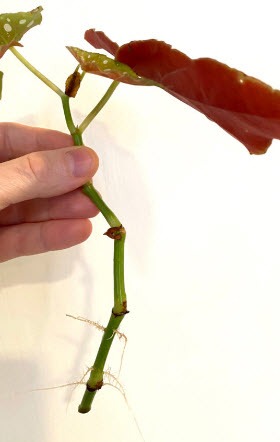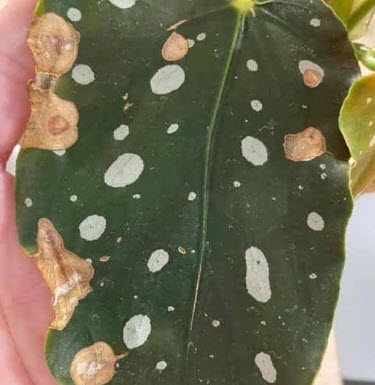Story of Day :
Begonia Maculata, otherwise known as the polka dot begonia, is a species of begonia that is native to Brazil. The plant is easily identified by its unique leaves which are covered in small, raised dots.

The flowers of the plant are typically pink or white in color. Begonia Maculata is a popular houseplant and is known for being relatively easy to care for.
Contents
- 1 Charasteristic Begonia Maculata
- 2 Humidity For Begonia Maculata
- 3 Polka Dot Begonia Light Requirements
- 4 How To Water Begonia Maculata
- 5 Soil Composition For Begonia Maculata
- 6 Temperature Requirements
- 7 Fertilizer
- 8 Flowering
- 9 Pruning
- 10 Propagating
- 11 Using Water Media
- 12 Using Soil
- 13 Repotting
- 14 Pest and Disease
- 15 Toxic
Charasteristic Begonia Maculata
The Begonia Maculata is a beautiful plant that is known for its dark green leaves and bright pink flowers. This plant is native to Brazil but can be found in many other countries as well.
The Begonia Maculata is a popular choice for gardens and indoor plants, as it is easy to care for and maintain.
This plant thrives in humid and warm climates and can reach up to 12 inches in height. The leaves of the Begonia Maculata are what give this plant its distinct appearance.
The leaves are large and oval-shaped, with a dark green color and silver spots. The flowers of the plant are also pink, and they bloom throughout the year.
The Begonia Maculata is an easy plant to care for and does not require much maintenance.
It is important to water this plant regularly, as it does not tolerate drought well.
The Begonia Maculata is also susceptible to pests and diseases, so it is important to check the plant regularly for signs of problems.
Humidity For Begonia Maculata
The ideal humidity for a Begonia Maculata is around 60%. This can be achieved by misting the plant regularly or by placing it on a pebble tray.
If the humidity drops below 60%, the leaves will start to curl and the plant will become stressed.
Polka Dot Begonia Light Requirements

The Polka Dot Begonia requires bright, indirect light.
It will do best near an east or west-facing window. If the light is too low, the leaves will become etiolated (long and thin).
If the light is too high, the leaves will develop sunburned spots.
How To Water Begonia Maculata

There are a few things to keep in mind when watering Begonia Maculata. First, the plant prefers moist but well-drained soil.
Second, water regularly, but allow the top inch or so of soil to dry out between watering. Third, during the winter months, water is less frequent, as the plant goes dormant.
Finally, avoid getting water on the leaves, as this can cause leaf spots.
Also, read about 10 types of begonia plants.
Soil Composition For Begonia Maculata
Begonia Maculata is a popular ornamental plant that is typically grown in pots or containers.
The ideal soil composition for this plant is one that is well-draining and rich in organic matter. A mixture of equal parts peat moss, perlite, and vermiculite is a good option.
Be sure to avoid using any soil that is too heavy or dense, as this can cause the roots to rot.
Temperature Requirements
The ideal temperature for Begonia Maculata is between 60 and 70 degrees Fahrenheit. However, they can tolerate temperatures as low as 50 degrees Fahrenheit.
They should be kept out of direct sunlight, as this can cause the leaves to scorch.
Fertilizer
There are a few things to keep in mind when fertilizing begonias maculate:
First, begonias are generally heavy feeders, so you’ll want to use a fertilizer that is high in nitrogen.
Second, begonias prefer slightly acidic soil, so using a fertilizer with a lower pH can be helpful.
And finally, begonias are sensitive to root burn, so it’s important to water the fertilizer well and not let the roots sit in the fertilizer for too long.
Fertilizing Begonia Maculata is a simple and easy process that can be done with just a few household items. All you need is some type of fertilizer, water, and a container to mix the two together.
The first step is to gather your materials. You will need fertilizer, water, and a container to mix everything together.
Any type of fertilizer will do, but it is important to make sure that the fertilizer is diluted properly. In general, you should mix one part fertilizer with nine parts water.
Once you have all of your materials, it is time to start fertilizing. Begin by adding the fertilizer to the container.
Then, slowly add the water and stir everything together. It is important to add the water slowly so that the fertilizer does not become too concentrated.
After the fertilizer and water are mixed together, you can begin applying them to the begonia maculata.
Simply pour the mixture over the plant, making sure to evenly distribute it. It is best to fertilize the plant every two weeks or so.
By following the steps above, you can ensure that your plant stays healthy and grows properly.
Also, read about Scarlet Begonia growing and care.
Flowering

The flowering time of Begonia Maculata is typically between late summer and early fall.
However, the exact timing will depend on the growing conditions and the variety of plants. For example, some varieties of Begonia Maculata will flower earlier in the season than others.
There are many different species of begonia, and the flowering begonia maculata is just one of them.
This particular type of begonia is known for its beautiful, brightly-colored flowers.
The blooms can be either pink or white, and they are dotted with dark spots. The flowers are quite large, and they grow in clusters on the plant.
Pruning
Begonia Maculata, commonly known as the variegated begonia, is a hardy succulent plant that can be pruned to maintain its desired shape and size.
There are a few general tips to follow when pruning this plant:
1. Begin by selecting a good cutting limb or stem. Make the cut just below a node (the point where a stem branches out from the main trunk).
2. Make further cuts at equal intervals along the cutting limb or stem, keeping the cuts close to the surface of the plant.
3. Finally, remove any dead or diseased tissue from the cutting. Begonia Maculata should be kept relatively healthy and free from diseases by regular pruning.
Propagating
Begonia Maculata is a succulent plant that is commonly propagated via stem cuttings. To propagate Begonia Maculata, first, remove a healthy stem from the plant.
Make sure to cut the stem at a medium height, just below the node.
Using Water Media

Stem cuttings: Cut the stem just above a strong leaf node, leaving a few leaves. Cure the cutting in a glass jar with sand in it, and keep it in a shaded place until roots form. After 3–4 weeks, plant it in soil.
Leaf cuttings: Cut the leaf from the plant with at least 2 nodes just above a strong vein, about 2 cm above a node. Dried then kept in a glass jar with sand, in a shaded place until roots appear. After 3–4 weeks, plant cuttings in soil or small pot.
Using Soil

It can be propagated easily by dividing the roots or stems.
Take a tuberous root or stem, cut off just below the node and plant it in the soil.
The plant will grow over time and eventually form roots. If you want to propagate more plants and get them started sooner, you can divide the plant at this stage.
You can also cut from the stem of the plant, but you will need to allow them to harden before planting. Place cuttings into the soil or a soil-less system, spacing them about 4 inches apart.
Begonia Maculata likes brightness and good air circulation so try to place your cuttings in a sunny window or in a brightly lit room. They should root within 2-3 weeks.
Repotting

Repotting Begonia Maculata is a common practice for many reasons.
One reason is that Begonia can get root bound and not be able to spread their roots. Another reason is that Begonia can get too large for their pot and start to grow in all directions.
Repotting allows the Begonia to grow in a more confined space which will help them look their best.
Pest and Disease

There are a number of diseases and pests that can affect Begonia Maculata. One common disease is brown heart, which is caused by the fungus Phytophthora Cinnamomi.
This fungus attacks the Begonia’s roots and can cause the plant to die.
Other diseases that can affect Begonia Maculata include Powdery mildew, Blackspot, and Verticillium wilt. Pests that can infest Begonia Maculata include the aphids, whiteflies, and mealybugs.
You can prepare for an insecticidal soap spray or insecticidal oil application by using a short-acting organic pesticide before releasing beneficial predators like ladybugs.
It is also possible to use a short-acting organic pesticide to help before releasing beneficial predators like ladybugs to gobble the remaining pests.
Toxic
The ASPCA believes that Begonia Maculata is toxic to dogs, cats, and horses. The roots contain the main amount of toxins, but the stems and leaves can cause oral irritation.